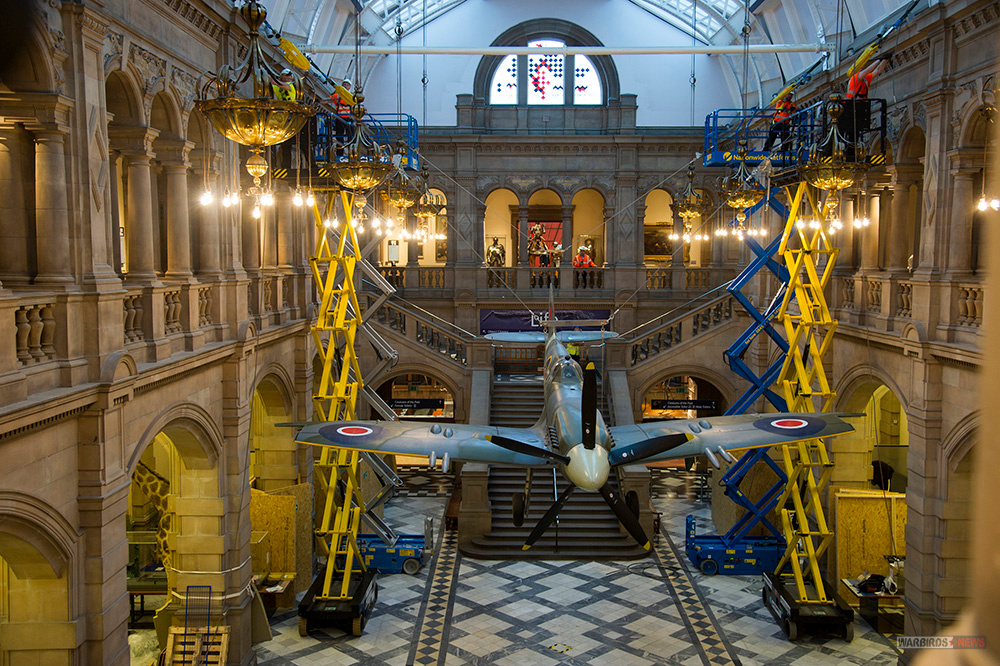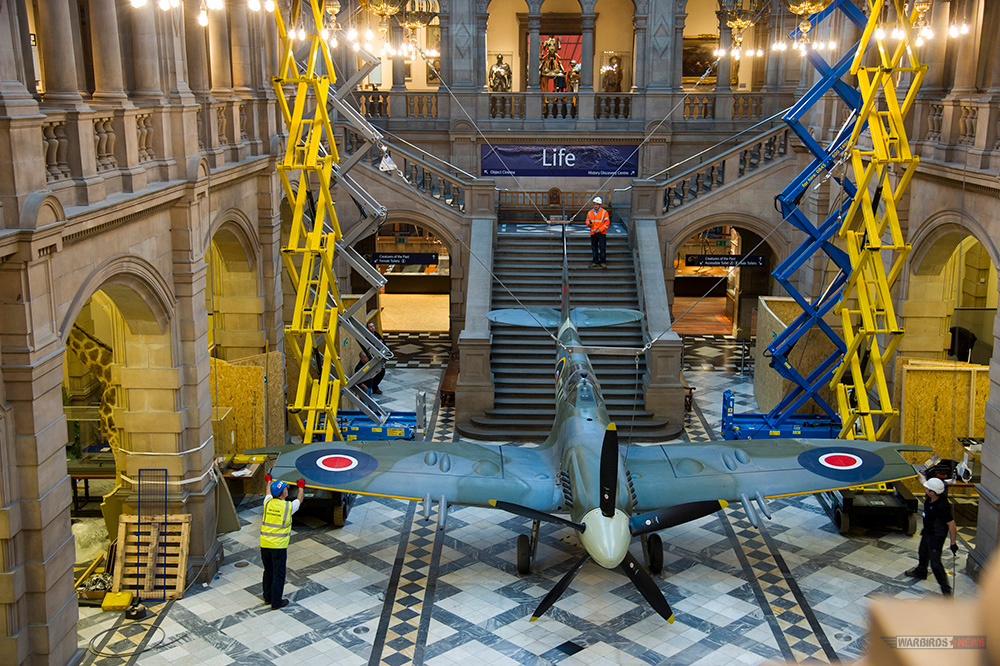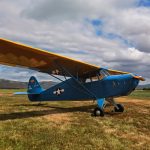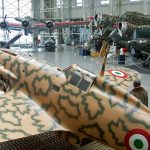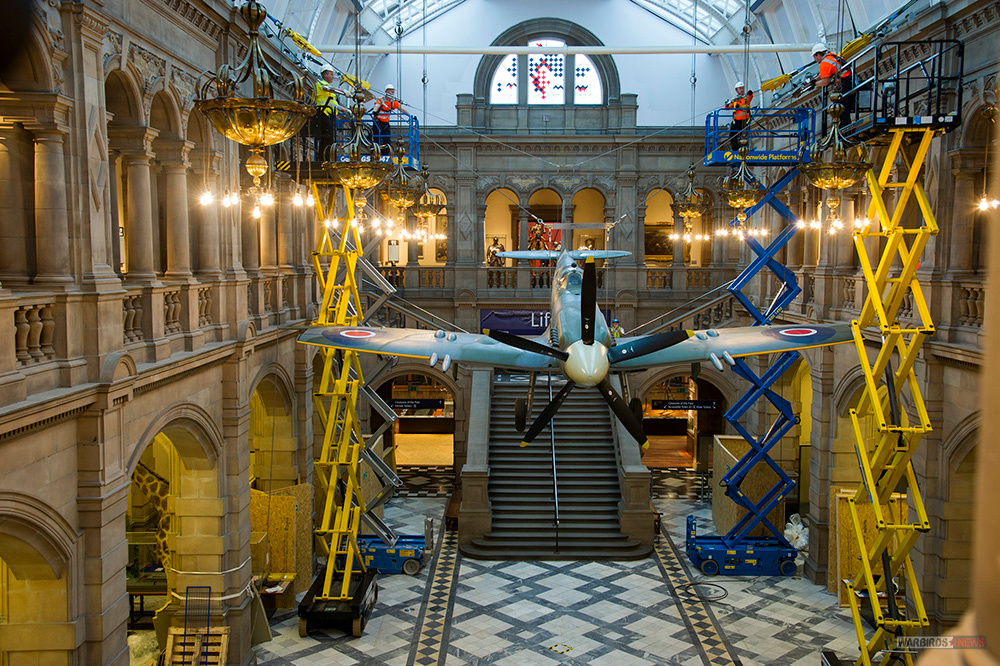
The Kelvingrove Art Gallery and Museum in Glasgow, Scotland is one of the most unusual (and beautiful) places you might find a classic WWII fighter plane such as a Supermarine Spitfire, and yet there she hangs in the main atrium. At least that’s where you could see her until a couple of weeks ago when museum staff lowered the rare Spitfire Mk.21 LA198 to the floor for her “once-in-a-decade conservation checks”. The museum building itself is a magnificent example of the finest in late-Victorian architecture, having opened in 1901 as the Palace of Fine Arts in the Glasgow International Exhibition. It houses an eclectic mix of world-class fine art exhibits, archeological artifacts, natural history displays, etc. and is apparently the most visited museum in the United Kingdom outside of London.
LA198 rolled off the Vickers-Supermarine factory production line in South Marston in September, 1944, with her first flight taking place on September 21st. By October 2nd, the Spitfire was with 33 MU at RAF Lyneham, near Bristol. She didn’t join an active squadron until late April, 1945 though, when 1 Squadron took her on charge at RAF Coltishall. The squadron moved to RAF Ludham in mid-May, but remained in England for the remainder of the war. actually belongs to the City of Glasgow. LA198 entered storage in October, 1946 at RAF Cosford, before heading up to RAF Abbottsinch in Scotland in May, 1946 to join 602 (City of Glasgow) Squadron with the Royal Auxiliary Air Force; and thus began this Spitfire’s long association with Scotland and this historic city. The aircraft suffered a ground loop following engine failure in mid-49, and damage was extensive enough that the fighter had to return to the factory at South Marston for repairs, which took a year to complete. Shortly afterwards, LA198 returned to 33 MU for storage which lasted a little over a year before reassignment to No.3 Civilian Anti-Aircraft Co-operation Unit in Exeter. The Spitfire served two years with the civilian-manned unit, which was known for towing aerial targets for the military. LA198 retired from active service in November, 1953, entering storage at Cosford until a decision could be made about her future, which came the following February when the RAF presented her to 187 Squadron ATC (Air Cadets) in Worcester as a ground instruction airframe, although she was effectively a gate guard outside the unit’s hut for the next decade or so. She was looking pretty rough by 1967 when the RAF recalled the aircraft to Henlow, along with more than a dozen other Spitfires from various places around the country for sprucing up to take part in the film “The Battle of Britain”. LA198 served as a static aircraft in the background during some of the scenes at Duxford. Following filming, the Royal Air Force put her on a plinth as a gate guard outside RAF Station Locking, where she stayed for the next fifteen years or so. During this time she donated some of her parts, including her Griffon engine, to the RAF Battle of Britain Flight Spitfire Mk.XIX fleet. In 1986, she came down from her pole and move to RAF Leuchars, near Fife in Scotland. Here she received a full refurbishment, and a return to her City of Glasgow markings. In 1989, the RAF brought all of their Spitfire gate guardians in from the cold, gathering them at RAF St.Athan. They soon transferred LA198 to the RAF Museum reserve collection in the old dirigible hangar at RAF Cardington, where she stayed for most of the 1990s until the MoD decided to make a formal gift of the Spitfire to the City of Glasgow in recognition of her Scottish heritage. LA198 moved up to the National Museum of Flight at the former RAF East Fortune just east of Edinburgh in 1998 where museum staff restored the Spitfire back to pristine, static condition on behalf of the City of Glasgow. She was finally ready for display in the freshly refurbished Kelvingrove Art Gallery and Museum in 2006 and suspended on a specially made gantry in the museum’s Life Gallery, where she has become a highly popular exhibit. The museum is in the process of reconfiguring the gallery, and took this opportunity to bring the Spitfire down for inspection.
The museum’s press release about their Spitfire follows…
Once on the ground museum bosses are keen to encourage visitors to watch the work being undertaken and view the spitfire in the rather unusual position of being on the ground, rather than in the air. The maintenance and conservation checks will necessitate the spitfire being temporarily off display for around six weeks from late October 2015, although the public can see it from the West Balcony during most of the redisplay work. Chair of Glasgow Life, Councillor Archie Graham, said: “The spitfire is one of the most popular objects on display in Kelvingrove. It consistently ranks highly on the must-see list of many of the million-plus people who visit the museum every year. “Those visiting in the coming weeks will have the unusual opportunity to look down upon, rather than gaze upwards at, this historically important and striking aircraft while we complete some essential conservation checks. “Once the spitfire is raised back into its normal position we can complete the first stage of the Life Gallery resign, which is one of the largest display changes at Kelvingrove since the building re-opened in 2006. We are delighted to be able to show more of the city’s natural history collection and enable the many people who visit Kelvingrove every year to see and learn more about some incredible animals.” Charlie Latham, Project Manager, Allelys Group, who undertook the lowering of the spitfire said: “It’s been a privilege to work with the museum on lowering the spitfire to the ground for checks. Our work often involves delicate objects, which brings an added pressure to the role, but it’s been great to be in such a stunning location, working on such an important object. And with today being Armistice Day it brings an added dimension to the job.”
WarbirdsNews wishes to thank Winnie Tyrrell, photo library coordinator for Glasgow Life/Glasgow Museums very much for her help in preparing this article.









